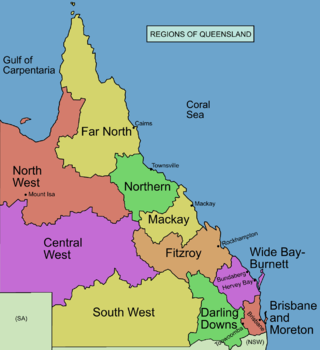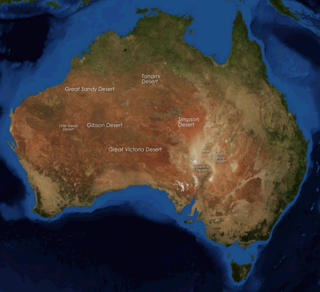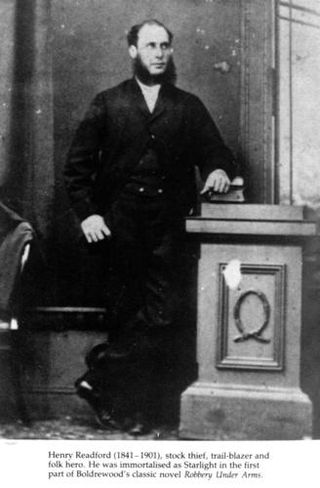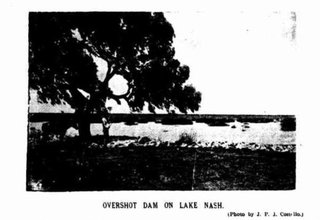
The Darling Downs is a farming region on the western slopes of the Great Dividing Range in southern Queensland, Australia. The Downs are to the west of South East Queensland and are one of the major regions of Queensland. The name was generally applied to an area approximating to that of the Condamine River catchment upstream of Condamine township but is now applied to a wider region comprising the Southern Downs, Western Downs, Toowoomba and Goondiwindi local authority areas. The name Darling Downs was given in 1827 by Allan Cunningham, the first European explorer to reach the area and recognises the then Governor of New South Wales, Ralph Darling.
Barkly is an electoral division of the Legislative Assembly in Australia's Northern Territory. It was first created in 1974, and is named after the Barkly Tableland area, which occupies much of the electorate. Barkly is a rural electorate, covering 442,868 km2 and taking in the towns of Tennant Creek, Borroloola, Ali Curung, Warrego, Tara Aboriginal Community and Alpururulam. There were 5,690 people enrolled in the electorate as of August 2020.

The deserts of Australia or the Australian deserts cover about 1,371,000 km2 (529,000 sq mi), or 18% of the Australian mainland, but about 35% of the Australian continent receives so little rain, it is practically desert. Collectively known as the Great Australian desert, they are primarily distributed throughout the Western Plateau and interior lowlands of the country, covering areas from South West Queensland, Far West region of New South Wales, Sunraysia in Victoria and Spencer Gulf in South Australia to the Barkly Tableland in Northern Territory and the Kimberley region in Western Australia.

Henry Arthur Readford, was an Australian stockman, drover and cattle thief.

The Carpentaria tropical savanna is a tropical and subtropical grasslands, savannas, and shrublands ecoregion in northern Australia.

The Einasleigh Uplands is an interim Australian bioregion, with vegetation consisting of savanna and woodland located on a large plateau in inland Queensland, Australia. It corresponds to the Einasleigh Uplands savanna ecoregion, as identified by the World Wildlife Fund.

The Mulga Lands are an interim Australian bioregion of eastern Australia consisting of dry sandy plains with low mulga woodlands and shrublands that are dominated by Acacia aneura (mulga). The Eastern Australia mulga shrublands ecoregion is coterminous with the Mulga Lands bioregion.
Anthony Lagoon is a cattle station on the Barkly Tableland in the Northern Territory, Australia. It is situated approximately 215 kilometres (134 mi) east of Elliott and 227 kilometres (141 mi) south of Borroloola. Eva Downs is run as an outstation of Anthony Lagoon and employs a separate manager, but is part of the same operation.

Alexandria Station is a pastoral lease that operates as a cattle station. It is the Northern Territory's largest pastoral property and Australia's third largest pastoral property, after Anna Creek station and Clifton Hills Station.

Brunette Downs Station, mostly referred to as Brunette Downs, is a pastoral lease operating as a cattle station in the Northern Territory of Australia.
Helen Springs Station more commonly known as Helen Springs is a pastoral lease that operates as a cattle station.
Walhallow Station also once known as Walhallow Downs often just referred to as Walhallow is a pastoral lease that operates as a cattle station in the Northern Territory of Australia.
Mittiebah Station, mostly referred to as Mittiebah, is a pastoral lease operating as a cattle station in the Northern Territory of Australia.

Lake Nash Station, most commonly known as Lake Nash, is a cattle station on the Barkly Tableland in the Northern Territory, Australia.

Alroy Downs Station is a pastoral lease that operates as a cattle station in Northern Territory.
Connells Lagoon Conservation Reserve also known as Dalgajini is a protected area in the Northern Territory of Australia.

The Gregory River is a river in the Northern Territory and the state of Queensland, Australia. The river is the largest perennial river in arid and semi-arid Queensland, one of the few permanently flowing rivers in the northwest of Queensland.

The Barkly Tableland death adder is a species of venomous snake in the family Elapidae. The exact distribution of the species is unclear, but suitable habitat for the plains death adder consists of flat, treeless, cracking-soil riverine floodplains. Based on the presence of suitable habitat, the potential geographic range for this species extends from Western Queensland, across the north of the Northern Territory to north-east Western Australia. Disjunct populations of the plains death adder are known to occur in the Mitchell Grass Downs of western Queensland, the Barkly Tableland on the Northern Territory/Queensland border and east of Darwin in the Northern Territory. The snake is named after former Prime Minister of Australia Bob Hawke.
The Wambaya people, also spelt Umbaia, Wombaia and other variants, are an Aboriginal Australian people of the southern Barkly Tableland of the Northern Territory. Their language is the Wambaya language. Their traditional lands have now been taken over by large cattle stations.
Tablelands is a locality in the Northern Territory of Australia located about 858 kilometres (533 mi) south-east of the territory capital of Darwin.




















